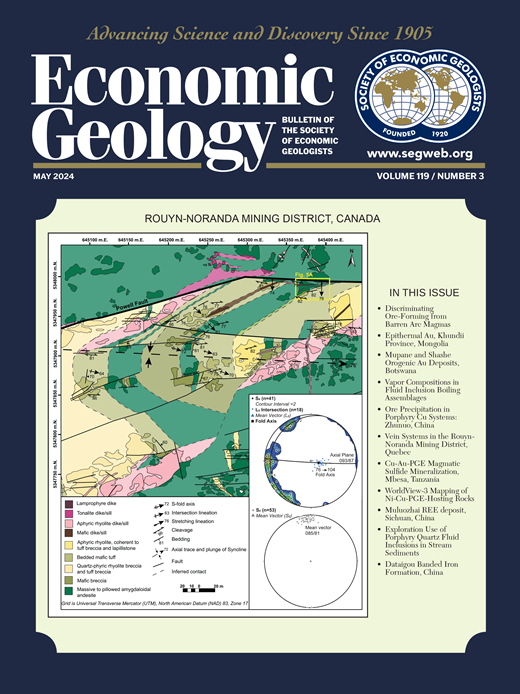Ore-Grade Estimation from Hyperspectral Data Using Convolutional Neural Networks: A Case Study at the Olympic Dam Iron Oxide Copper-Gold Deposit, Australia
IF 4.9
1区 地球科学
Q1 GEOCHEMISTRY & GEOPHYSICS
引用次数: 0
Abstract
Acquiring information about the spatial distribution of ore grade in the subsurface is essential for exploring and discovering mineral resources. This information is derived commonly from the geochemical analysis carried out on drill core samples, which allows the quantification of the concentration of ore elements. However, these surveys are generally time-consuming and expensive, usually leading to information at a low spatial resolution due to large sampling intervals. The use of hyperspectral systems in the mining industry to characterize and quantify minerals in drill cores is increasing due to their efficiency and fast turnaround time. Here, we propose the use of convolutional neural networks on hyperspectral data to estimate Cu concentration in drill cores at the Olympic Dam iron oxide copper-gold deposit. The Cu concentration data obtained by drill core geochemical analysis and the mean spectra between the analyzed intervals obtained from hyperspectral data were used to train the machine learning model. The trained model was then used to estimate the Cu concentration of a test drill core, which was not used to train the model. In addition, the trained model was used to extrapolate the Cu concentration, at a centimetric spatial resolution, to the drill core intervals without geochemical analysis. Qualitative and quantitative evaluations of the results demonstrate the capabilities of the proposed method, which provided a root mean squared error of 0.48 for the estimation of Cu percentage along drill cores. The results indicate that the method could be beneficial for determining the spatial distribution of ore grade by supporting the selection of zones of interest where more detailed analyses are appropriate, reducing the number of samples needed to characterize and identify the ore zones, and assisting in the estimation of the volume with commercially viable ore, thereby potentially reducing the geochemical assays needed and decreasing the data acquisition time.利用卷积神经网络从高光谱数据估计矿石品位:以澳大利亚奥林匹克坝氧化铁铜金矿为例
获取地下矿石品位的空间分布信息是勘查和发现矿产资源的必要条件。这些信息通常来自对钻孔岩心样品进行的地球化学分析,从而可以量化矿石元素的浓度。然而,这些调查通常耗时且昂贵,由于采样间隔大,通常导致信息的空间分辨率低。由于高光谱系统的效率和快速周转时间,在采矿业中越来越多地使用高光谱系统来表征和量化岩心中的矿物。在这里,我们建议使用卷积神经网络对高光谱数据进行估计,以估计奥林匹克坝氧化铁铜金矿床岩心中的Cu浓度。利用岩心地球化学分析获得的Cu浓度数据和高光谱数据获得的分析区间之间的平均光谱来训练机器学习模型。然后使用训练好的模型来估计测试岩心的Cu浓度,而不是使用测试岩心来训练模型。此外,在没有地球化学分析的情况下,利用训练好的模型在厘米空间分辨率下推断出钻芯层段的Cu浓度。定性和定量评价结果证明了该方法的有效性,该方法对沿岩心方向的铜含量估算的均方根误差为0.48。结果表明,该方法有利于确定矿石品位的空间分布,支持选择更详细分析的感兴趣区域,减少表征和识别矿带所需的样品数量,并协助估计具有商业可行性的矿石的体积,从而可能减少所需的地球化学分析和减少数据采集时间。
本文章由计算机程序翻译,如有差异,请以英文原文为准。
求助全文
约1分钟内获得全文
求助全文
来源期刊

Economic Geology
地学-地球化学与地球物理
CiteScore
10.00
自引率
6.90%
发文量
120
审稿时长
6 months
期刊介绍:
The journal, now published semi-quarterly, was first published in 1905 by the Economic Geology Publishing Company (PUBCO), a not-for-profit company established for the purpose of publishing a periodical devoted to economic geology. On the founding of SEG in 1920, a cooperative arrangement between PUBCO and SEG made the journal the official organ of the Society, and PUBCO agreed to carry the Society''s name on the front cover under the heading "Bulletin of the Society of Economic Geologists". PUBCO and SEG continued to operate as cooperating but separate entities until 2001, when the Board of Directors of PUBCO and the Council of SEG, by unanimous consent, approved a formal agreement of merger. The former activities of the PUBCO Board of Directors are now carried out by a Publications Board, a new self-governing unit within SEG.
 求助内容:
求助内容: 应助结果提醒方式:
应助结果提醒方式:


